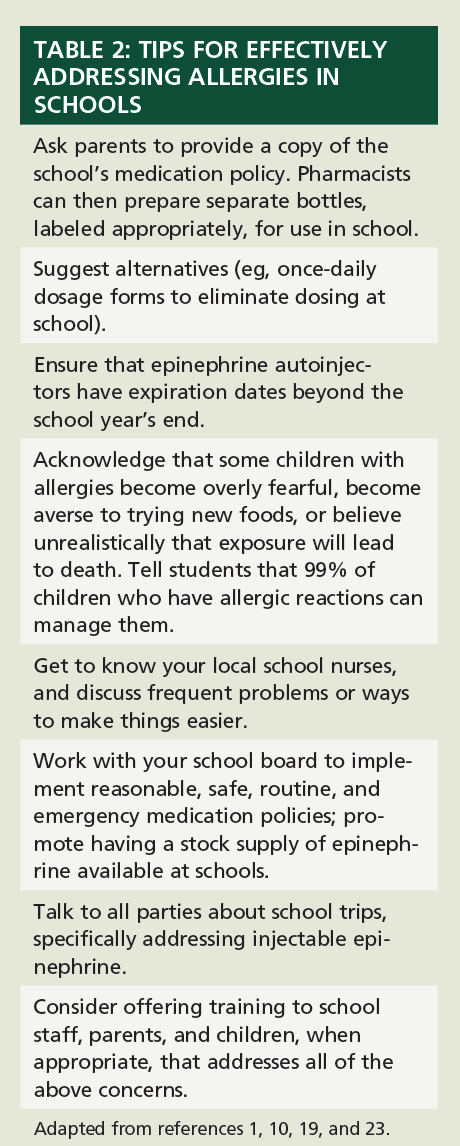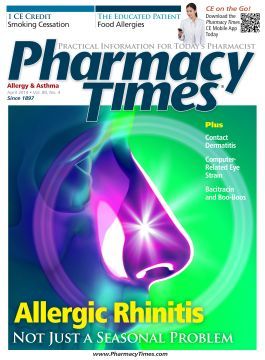Publication
Article
Pharmacy Times
Allergy & Asthma at School: Learning the ABCs
Author(s):
Pharmacists can take measures to help schoolchildren with allergies and asthma.
Pharmacists can take measures to help schoolchildren with allergies and asthma.
As many as 10% to 35% of schoolchildren have chronic health conditions, and 1% have severe, chronic health conditions1-4 (Online Table 15,6). For children with serious allergies, making it through each school day is like running an obstacle course. Children with health issues often struggle academically. Pharmacists should understand the issues surrounding medication use by children in school and should especially focus on 2 of the most prevalent concerns—allergies and asthma.
Table 1: Common Illnesses/Conditions in Schoolchildren
Chronic Illnesses
Acute Illnesses
- Addiction/Abuse
- Asthma
- Attention-deficit/hyperactivity disorder
- Diabetes
- Eating disorders
- Food allergy
- Hay fever
- Mental health issues (eg, anxiety, depression, panic disorder, self-harm)
- Migraine headache
- Obesity
- Sexuality issues (eg, birth control, gender misalignment)
- School refusal (eg, teasing, bullying, “social morbidities”)
- Sleep disorders
- Abdominal pain
- Anaphylaxis/emergency response
- Child abuse
- Fracture or sprain
- Infection
- Laceration
- Outbreaks (influenza, lice, scabies)
- Psychiatric emergency
- Seizure
- Sexuality (pregnancy, rape)
- Vaccination monitoring and administration
- Vision and hearing screening
Adapted from references 5 and 6.
A Is for Allergies and Asthma
Allergies and asthma go hand in hand for many children.7 Experts believe that 25% to 33% of children have allergies, but the exact number is unknown.2,3 Approximately 9% of children have hay fever, 10% have respiratory allergies, and 12% have skin allergies. The Centers for Disease Control and Prevention estimates that approximately 5.6% of American children have food allergies and that 9% of children have asthma.8-12
B Is for Bee Sting
Approximately 5% to 10% of individuals experience anaphylaxis in response to bee stings. These individuals may also react to other types of stings, such as those from wasps and hornets. Children don’t outgrow these allergies as was previously believed.13,14
C Is for Counseling
By necessity, pharmacists and school nurses need to counsel the parents of schoolchildren. Young children do not have the emotional and cognitive maturity to understand diagnosis and treatment; legally, parents are responsible for their children’s care. At around 11 years of age, children are usually mature enough to discuss their allergies and asthma independently (although parents must still be involved). Usually, parents’ and children’s descriptions of children’s allergies are fairly consistent, but children tend to emphasize their symptoms, while parents tend to emphasize treatment.3,15
D Is for Drugs
Medication use in schools is subject to myriad federal, state, and local policies. Children and their parents are often confused and frustrated by the rules, and pharmacists sometimes become embroiled in the tug-of-war between families and schools. In addition, a school nurse or unlicensed medication giver may be involved.
Today, approximately 74,000 school nurses provide care for our nation’s students. 16 They handle injuries (31% of children’s injuries occur at school), educate children about their conditions, create individualized care plans (called Individualized Health Care Plans or 504 plans) for students with chronic conditions, and administer medication.17,18 The National Association of School Nurses recommends a ratio of 1 nurse per 750 children, but it’s a rare school system that meets that ratio.19,20 Currently, fewer than half of public schools employ a full-time nurse. Twenty-five percent of schools are without nurses, which raises questions about who administers medications. Consider this example from a rural middle school: at one point, the only employees trained to help children with diabetes to inject insulin were a custodian and a records specialist.19
Consequently, each school system has its own policies on and procedures for medications and who can administer them.21 A student with seasonal allergies or asthma may need to leave class to receive a dose of medication, as most schools forbid students to carry medication. Some schools, however, allow students to carry inhalers. Some allow students of a certain age to carry 1 or 2 doses of OTC medications, while others completely forbid it.
E Is for Emergency
With children spending up to 50% of their waking hours at school, schools must be prepared for emergencies. Anaphylaxis is a major concern. Consider this: up to 15% of students with serious allergies will require treatment with epinephrine. Furthermore, students are at high risk for exposure to a food allergen or an insect sting. The American Academy of Allergy Asthma and Immunology’s 2010 position statement requires each student with allergies to have a personalized written emergency plan and a prescription for epinephrine; schools rarely comply with this recommendation. 4,21
The preferred treatment for anaphylaxis— epinephrine autoinjector—is dosed by weight (0.3 mg intramuscularly or subcutaneously if the child weighs 30 kg or more; half that dose if the child weighs less), so schools almost always require each student to have his or her own prescription. The drug is usually stored in the nurse’s office or in a designated medication room. School staff members must be trained to recognize anaphylaxis, find the student’s medication quickly, and use the injectors.10,22,23 In a study of anaphylactic reactions in children, 71% of parents used autoinjectors incorrectly; school staff is even less competent.24,25 This emphasizes a critical need: parents and school staff need periodic retraining.10,22,23

F Is for Forgetting
Forgetting doses is a big problem in schools. Most school policies require students to visit the nurse to administer medication. Students often forget and miss doses. Many children with serious allergies last experienced a reaction as toddlers, and they forget what a reaction feels like. They may have unnecessary anxiety about a potential reaction, or may not realize when one is starting. Furthermore, the school nurse may forget to check expiration dates or may leave a refrigerated medication on the counter in error, necessitating a call to the parents to replace the drug.1
Forgetting to take students’ epinephrine autoinjector pens on bus trips creates risk, but it commonly occurs. In addition, parents have reported that their children’s epinephrine autoinjectors go on a bus trip but remain on the bus while the students engage in the planned activity. Schools should have a policy addressing students’ health care issues. They should also ensure that at least 1 adult is trained to administer epinephrine; a good training module is available online at
elect “Training” from the top menu, and then “EpiPen Training” from the drop-down menu).26,27
Sometimes, the best that schools can do is (1) invite the parents of children with allergies or asthma to chaperone a trip or (2) exclude affected children from trips. Some schools allow students to carry 1 or 2 autoinjectors.
G Is for Growth
Emotional and cognitive growth, that is. Pharmacists can help schools, school systems, parents, and students by anticipating problems (Table 2). Lastly, pharmacists can work with parents so they will know when their children have the maturity to self-administer medications. Their lives may depend on it.
Virginia Bartok is a retired pharmacist who comes out of retirement to write about pharmacy trends and clinical updates. Her primary practice was in indigent care.
References:
- Farris KB, McCarthy AM, Kelly MW, Clay D, Gross JN. Issues of medication administration and control in Iowa schools. J Sch Health. 2003;73:331-337.
- Wickman M, Lilja G. Today, one child in four has an ongoing allergic disease in Europe. what will the situation be tomorrow? Allergy. 2003;58:570-571.
- Danell CS, Bergström A, Wahlgren CF, Hallner E, Böhme M, Kull I. Parents and school children reported symptoms and treatment of allergic disease differently. J Clin Epidemiol. 2013;66:783-789.
- Schoessler S, White MV. Recognition and treatment of anaphylaxis in the school setting: the essential role of the school nurse. J Sch Nurs. 2013;29:407-415.
- Olympia RP, Wan E, Avner JR. The preparedness of schools to respond to emergencies in children: a national survey of school nurses. Pediatrics. 2005;116:e738-e745.
- American Pediatrics Association. Role of the school nurse in providing school health services. Pediatrics. 2008;121:1231-1238.
- Chipps BE. Update in pediatric anaphylaxis: a systematic review. Clin Pediatr (Phila). 2013;52:451-461.
- Summary health statistics for US children: national health interview survey, 2012. Centers for Disease Control and Prevention website. www.cdc.gov/nchs/fastats/allergies.htm. Accessed March 18, 2014.
- Gunnarsson N, Marklund B, Ahlstedt S, Borell L, Nordström G. Allergy-like conditions and health-care contacts among children with exclusion diets at school. Scand J Caring Sci. 2005;19:46-52.
- Schoessler S. Epinephrine: the drug of choice for anaphylaxis. NASN Sch Nurse. 2013;28:52.
- Sicherer SH, Mahr T. Management of food allergy in the school setting. Pediatrics. 2010;126:1232-1239.
- Asthma facts and figures. Asthma and Allergy Foundation of America website. www.aafa.org/display.cfm?id=8&sub=42. Accessed March 20, 2014.
- Golden DBK. Epidemiology of allergy to insect venoms and stings. Allergy Proc. 1989;10:103-107.
- Golden DB. Insect sting anaphylaxis. Immunol Allergy Clin North Am. 2007;27:261-272, vii.
- Takeuchi J, Kusunoki T, Morimoto T, et al. Lifestyle risk factors for allergic rhinitis in schoolchildren: are sports activities a negative factor? J Aller Clin Immunol. 2013;131(SUPP):AB112.
- Monsalve L; NASN. NASN membership survey: developing and providing leadership to advance the school nursing practice. NASN Sch Nurse. 2010;25:176-181.
- Planning a career in school nursing? National Association of School Nurses website. www.nasn.org/RoleCareer/PlanningaCareerinSchoolNursing. Accessed March 18, 2014.
- Bannister A, Kelts S. NASN position statement: the role of the school nurse and school-based health centers. NASN Sch Nurse. 2011;26:196-197.
- No, the school nurse is not in. National Public Radio website. www.npr.org/2012/01/03/144615747/no-the-school-nurse-is-not-in. Accessed March 17, 2014.
- Guttu M, Engelke MK, Swanson M. Does the school nurse-to-student ratio make a difference? J Sch Health. 2004;74:6-9.
- Zacharski S, DeSisto M, Pontius D, Sheets J, Richesin C. For your information: management in the school setting: position statement. NASN Sch Nurse. 2013;28:263-265.
- Allen CW, Campbell DE, Kemp AS. EpiPen use in children with food allergies. Med J Aust. 2007;187:542.
- Segal N, Garty BZ, Hoffer V, Levy Y. Effect of instruction on the ability to use a self-administered epinephrine injector. Isr Med Assoc J. 2012;14:14-17.
- Gold MS, Sainsbury R. First aid anaphylaxis management in children who were prescribed an epinephrine autoinjector device (EpiPen). J Allergy Clin Immunol. 2000;106:171-176.
- Arkwright PD, Farragher AJ. Factors determining the ability of parents to effectively administer intramuscular adrenaline to food allergic children. Pediatr Allergy Immunol. 2006;17:227-229.
- EpiPen administration. Smith-Green Community Schools website. www.sgcs.k12.in.us/index.php?option=com_docman&Itemid=5. Accessed March 19, 2014.
- School field trip and Epi-pen question. DISboards.com. www.disboards.com/showthread.php?t=2297879. Accessed March 19, 2014.

Newsletter
Stay informed on drug updates, treatment guidelines, and pharmacy practice trends—subscribe to Pharmacy Times for weekly clinical insights.






